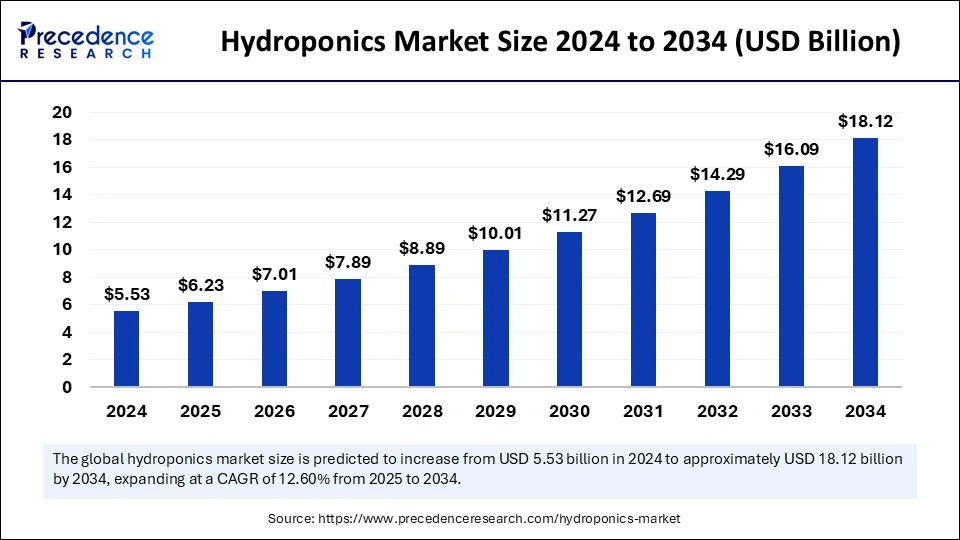The Hydroponics Sector is set to expand to USD 18.12 billion by 2034.
The hydroponics sector is set for significant growth, increasing from USD 5.53 billion in 2024 to an estimated USD 18.12 billion by 2034, at a CAGR of 12.60%.
Hydroponics Sector Key Insights
- Asia Pacific led the global hydroponics market with the largest share of 36% in 2024.
- Europe is estimated to expand at the fastest CAGR in the market between 2025 and 2034.
- By type, the aggregate segment held the biggest market share of 54% in 2024.
- By type, the liquid segment is anticipated to grow at a remarkable CAGR of 14.4% during the forecast period.
- By crop type, the tomatoes segment captured the largest share of 46% in 2024.
- By crop type, the lettuce segment is expected to expand at the highest CAGR of 15.6% over the studied period.
- By crop area, the above 50,000 sq.ft. led the market in 2024.

The hydroponics market is witnessing rapid growth as the demand for sustainable and efficient agricultural practices rises. Hydroponics is a soilless farming technique that utilizes nutrient-rich water solutions to grow crops, offering higher yields with reduced resource consumption. This method is gaining popularity due to its ability to optimize land use, conserve water, and ensure year-round crop production. The increasing global population, urbanization, and concerns over food security are key factors driving interest in hydroponic farming. With advancements in controlled environment agriculture (CEA) and precision farming, the hydroponics industry is poised for significant expansion in the coming years.
Sample Link: https://www.precedenceresearch.com/sample/5690
Market Drivers
Several factors are fueling the growth of the hydroponics market
- Rising Demand for Sustainable Agriculture – As traditional farming faces challenges like soil degradation and water scarcity, hydroponics offers a more sustainable alternative by using up to 90% less water and requiring minimal land.
- Increasing Urban Farming & Vertical Agriculture – The growth of urban agriculture and vertical farming is driving the adoption of hydroponics, especially in densely populated cities where space is limited.
- Technological Advancements – Innovations in LED lighting, automation, IoT-based monitoring systems, and AI-driven farming solutions are making hydroponic farming more efficient and accessible.
- Growing Awareness of Pesticide-Free & Organic Produce – Consumers are increasingly seeking fresh, pesticide-free, and organic produce, which hydroponic farming can deliver with minimal environmental impact.
- Government Support & Investments – Many governments are promoting hydroponic farming through subsidies, research grants, and initiatives aimed at boosting food security and sustainable agriculture.
Opportunities
The hydroponics market presents several opportunities for growth and innovation
- Expansion in Developing Regions – Countries in Asia, Africa, and Latin America are beginning to adopt hydroponic farming to address food security issues, creating new market opportunities.
- Integration of AI & IoT in Farming – Smart hydroponic systems equipped with AI and IoT can optimize nutrient delivery, monitor plant health, and enhance productivity, making hydroponics more efficient and scalable.
- Commercial Adoption by Retail & Hospitality Sectors – Restaurants, supermarkets, and hotels are increasingly investing in hydroponic systems to grow fresh produce on-site, ensuring quality and sustainability.
- Development of Cost-Effective Solutions – Reducing the initial costs of hydroponic systems through innovative and affordable technologies could expand adoption among small-scale farmers.
- Alternative Crop Production – Hydroponics enables the cultivation of high-value crops, including medicinal plants, herbs, and exotic vegetables, opening new revenue streams for farmers and agribusinesses.
Challenges
Despite its advantages, the hydroponics industry faces several challenges
- High Initial Investment & Maintenance Costs – Setting up hydroponic farms requires significant capital investment in infrastructure, lighting, and automation, making it less accessible for small farmers.
- Technical Expertise & Knowledge Gap – Hydroponic farming requires specialized knowledge in nutrient management, system maintenance, and climate control, posing a barrier to widespread adoption.
- Energy Consumption Concerns – Hydroponic systems, especially indoor vertical farms, rely heavily on artificial lighting and climate control systems, leading to high energy consumption.
- Regulatory & Legal Hurdles – In some regions, regulatory challenges related to water use, food safety, and hydroponic farming classification can slow market growth.
- Limited Crop Variety – While hydroponics is effective for leafy greens and herbs, certain staple crops like wheat, rice, and root vegetables are less suited for this method, limiting its application.
Regional Insights
- North America – The region dominates the hydroponics market, driven by technological advancements, increasing investments in controlled environment agriculture, and rising consumer demand for fresh and organic produce. The U.S. and Canada are major players, with large-scale hydroponic farms supplying grocery chains and restaurants.
- Europe – European countries, particularly the Netherlands, Germany, and the UK, are leading in hydroponic innovations. Strong government support, sustainable agriculture policies, and a focus on food security are accelerating market growth.
- Asia-Pacific – The fastest-growing region for hydroponics, with countries like China, India, and Japan adopting the technology to enhance food production in urban areas. Rising population and limited arable land are key drivers.
- Latin America & Middle East & Africa – Though still emerging, hydroponic farming is gaining traction in regions facing water scarcity and harsh climates. Investments in agritech and urban farming initiatives are expected to fuel growth.
Read Also: Fertilizer Market
Market Companies
Segments Covered in the Report
By Type
- Aggregate Systems
- EBB & Flow Systems
- Wick Systems
- Drip Systems
- Liquid Systems
- Deep Water Culture
- Aeroponics
- Nutrient Film Technique (NFT)
By Crop Type
- Tomatoes
- Peppers
- Lettuce
- Herbs
- Cucumbers
- Others
By Crop Area
- Upto 1000 sq.ft.
- 1000-50,000 sq.ft.
- Above 50,000 sq.ft
By Geography
- North America
- Asia Pacific
- Europe
- South America
- Middle East and Africa (MEA)
